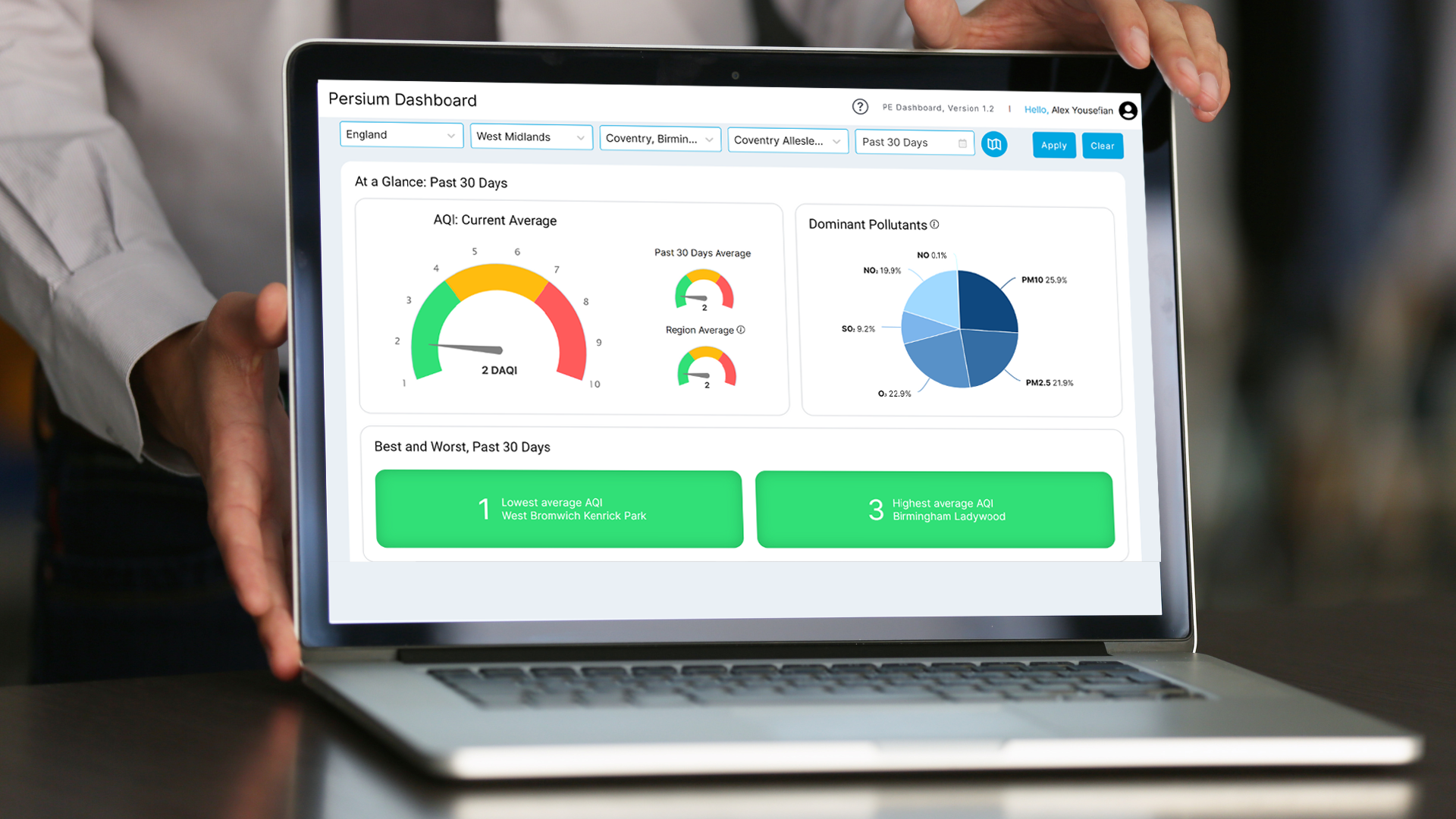Reading Time: 8 minutes
There is no debate that the quality of the air we breathe every day significantly impacts our life. In a larger scope, air pollution is causing harm to the state of the environment and economic consequences. More than $5 trillion is spent annually on welfare expenditures and health problems as a result of air pollution worldwide. And the number continues to rise if there are no actions taken right away.
This urgency has fueled the emergence and evolution of air quality monitoring over recent years. These solutions are instrumental for businesses, governments, and communities, providing them with robust and comprehensive air quality data. This data, in turn, empowers informed decision-making for improved environmental health and strategic planning.
In this article, we’ll dig into air quality monitoring – how it works, its importance, and how it helps us make better decisions for a healthier, cleaner tomorrow.
Table of Contents
All you need to know about air quality monitoring
Air quality monitoring (AQM) refers to the process of collecting and measuring the levels of various pollutants present in the air. These pollutants include particulate matter (PM), gases like carbon monoxide (CO), sulfur dioxide (SO2), nitrogen oxides (NOx), ozone (O3), and volatile organic compounds (VOCs) and so forth.
The data collected through monitoring air quality is used to compare certain levels of air quality in a specific region or location. It allows us to identify the state of the air, identify potential sources of pollution, and get real-time information so that policymakers can make better data-driven decisions on air quality management.
In the following sections, we unravel AQM’s history and evolution, the benefits AQM brings, and how it works. We also provide an overview of industries that should use Air Quality Monitoring systems.
History of air quality monitoring and the initial challenges
The advent and evolution of Air Quality Monitoring go hand-in-hand with rising air pollution because of its adverse impact worldwide.
In the late 1940s, scientists first created air pollution monitoring equipment. They had to start from scratch because little was known about the chemical makeup of pollution. Moreover, it had never been quantified. Later, they established alert systems and station monitoring networks to provide ongoing data on air quality for measuring and predicting smog levels. However, the equipment is complex and needs a lot of maintenance.
During the early days, we saw several challenges encountered in monitoring air quality. First is the limited understanding of pollutants. Measuring specific pollutants may be a real headache as the analytical techniques and equipment were not as advanced as they are today. Secondly, there are limited monitoring networks. Because of the limitation in scope and coverage, stations are installed sparsely, primarily focused on urban areas. Thirdly, monitoring instruments were bulky, expensive, and required skilled operation and maintenance. Therefore, it narrowed down the number of monitoring stations and the measurements’ frequency.
Moreover, managing and analysing the vast amount of data collected from monitoring stations required substantial resources and expertise. Lacking these might make the data process time-consuming and the unavailability of real-time and accurate data. Additionally, there are regulatory gaps in many regions to tackle air pollution. Unclear regulations lead to less incentive for industries to take control over their emissions. Additionally, efforts put into monitoring are not mandatory.
Air pollution monitoring has been evolving since the air is keeping worse due to the vast increase in industrial emissions, the burning of fossil fuels, wire fires, transportation, and so on. This solution has become more and more aware as the air pollution issue receives wider public attention worldwide. For instance, it is estimated that the global air quality monitoring market size is set to achieve USD 8.6 billion in 2032.

Benefits of air quality monitoring
As there has been a significant increase in air pollution challenges in recent years, monitoring air quality is much more essential than ever. Here are the benefits of air quality monitoring:
Protect our health
Some pollutants in the air can have detrimental effects on our health, and it’s hard to identify the quality of the air you breathe without analysing data collected from monitoring. By detecting and measuring pollutants such as ozone, carbon monoxide, sulfur dioxide, nitrogen dioxide, etc., policymakers can take control actions to improve air quality. Therefore, this helps to mitigate health risks like respiratory problems, cardiovascular diseases, and other illnesses caused by poor air quality, leading to a better quality of life.
Boost environmental management
Implementing air quality sensors helps keep a check on pollution sources and emissions from specific locations like industrial zones or mining areas. Policymakers can base on accurate and up-to-date information on pollutant levels so that they can understand the magnitude of the problem and develop strategies to mitigate the pollution. Hence, implementing air quality monitoring systems enables them to make informed decisions on regulations like urban planning, transport systems, etc.
Support research and innovation
Air quality monitoring provides researchers with valuable data for analysis practices. As technology and industrial practices evolve, more and more new pollutants are present in the air. Consequently, this leads to changes in air pollution, like seasonal variations or climate changes. By analysing this data, researchers can understand their sources and identify changes and trends in air pollution. This helps them design and improve technologies for emission control and treatment systems and streamline the development of mitigation strategies.
Mitigate the effects of climate change
Undoubtedly, air pollution monitoring plays an important role in helping mitigate the effects of climate change. While the primary focus of AQM is ensuring that we are breathing safe air, it’s worth mentioning the benefits of AQM to climate change. Greenhouse gasses such as carbon dioxide (CO2), methane (CH4), and nitrous oxide (N2O) are major contributors to global warming and climate change. Efficient measures aimed at reducing such pollutants help reduce air pollution and contribute to reducing greenhouse gasses, leading to mitigating climate change.
Which industries should use Air Quality Monitoring systems?
To ensure compliance with environmental regulations and reduce the impact of operations on the environment, AQM solutions are crucial across various industries. Let’s see which industries use air quality monitoring systems.

Smart cities & Urban Environment
Provide real-time data on local air pollution concentration, its sources (whether local or originating from outside the assigned area), and the ability to recognise events that contribute to spikes at specific times of the day.
Schools and Universities
Identify and mitigate air pollutants outside the schools, across campus and indoors that affect the health and well-being of students and staff.
Healthcare Providers
Monitor sources of pollution and identify pollution hotspots and periods when emissions are at their highest, helping protect patients and improve patients care outcomes.
Research Institutions
Gather accurate and thorough information on pollutant levels and emission sources to understand pollution patterns, identify trends. Monitoring air quality is essential for various research activities, particularly in environmental science, climate change, public health, and industrial innovation.
Mining and Quarrying
Air quality monitoring can help ensure worker safety by detecting harmful substances in the air, such as methane, dust particles, and radon. It can also help companies comply with occupational health and safety regulations.
Construction
Monitoring air quality at construction sites can help manage these pollution sources, protect workers’ health, and ensure regulatory compliance. It can also help inform environmental impact assessments and mitigation strategies.
Transport and Traffic Management
Provide crucial data to identify pollution hotspots, which are usually located around transportation hubs or areas with considerable traffic. This data can also be used to promote green transportation initiatives, such as cycling or electric vehicle usage, and improve urban planning.
Governments and Policymakers
Facilitate data-driven decision-making by providing accurate and up-to-date information on pollutant levels, emission sources, and air quality trends. Policymakers can use this information to enforce pollution controls, inform the public about air quality issues, and guide investment in cleaner technologies or infrastructure.
Ready to make a difference to the quality of air the world breathes?
Download our product information sheet and brochure to learn more.

How does Air Quality Monitoring work?
Monitoring air quality involves measuring different pollutants and contaminants present in the air. There are many methods and instruments used in air quality monitoring practices, including the following stages:
Measure air quality by stations or low-cost sensors.
Ambient Air Monitoring Stations: Store Stationary monitoring stations in various areas to measure the level of air pollution in that area or region. They have a range of sensors to measure pollutants, then collect and analyse data to assess air quality levels.
Besides stations, portable monitoring devices are also used to monitor air quality. It is mostly for on-the-go measurements in specific environments or carried by individuals.

The Persium Pod is the next generation of air quality sensors. Stepping beyond traditional sensors, the Persium Pod boasts a unique, patent-pending technology that allows it to differentiate between water vapor and dust or pollen, an industry first. Additionally, it can track 3D wind speed, key to analysing the trajectory of air pollution and identifying its sources.
Collect air quality data.
Traditionally, after measuring the level of air quality, air samples are analysed in a laboratory setting using specialized devices such as filters, canisters, or sorbent tubes. However, due to the advancement in technology, there are the advent and development of small, low-cost sensors that are implemented in networks for distributed AQM. Integrating sensors into Internet of Things(IoT) devices enables the collection of real-time data, which is ideal for high-density spatial coverage and community-based monitoring initiatives.
Analyse data and forecast.
After data is collected from the monitoring devices, it undergoes quality assurance and validation procedures to guarantee accuracy and reliability. This data is then processed, analyzed, and often displayed in real-time on a dashboard. This information can be accessed through a website or a mobile app. Government agencies, researchers, and policymakers rely on this analysis to assess air quality levels, identify sources of pollution, and make well-informed decisions about public health, environmental management, and policy.

Persium Dashboard is the most sophisticated analytical visualisation platform on the market to support accurate air quality data forecasts & analysis. It provides heatmaps, isobars, and wind data to contrast pollution plume movements. Moreover, it offers sophisticated graphing tools and comparison features along with AI-driven prediction forecasts for extended periods, adding another layer of convenience and precision to air quality monitoring.


